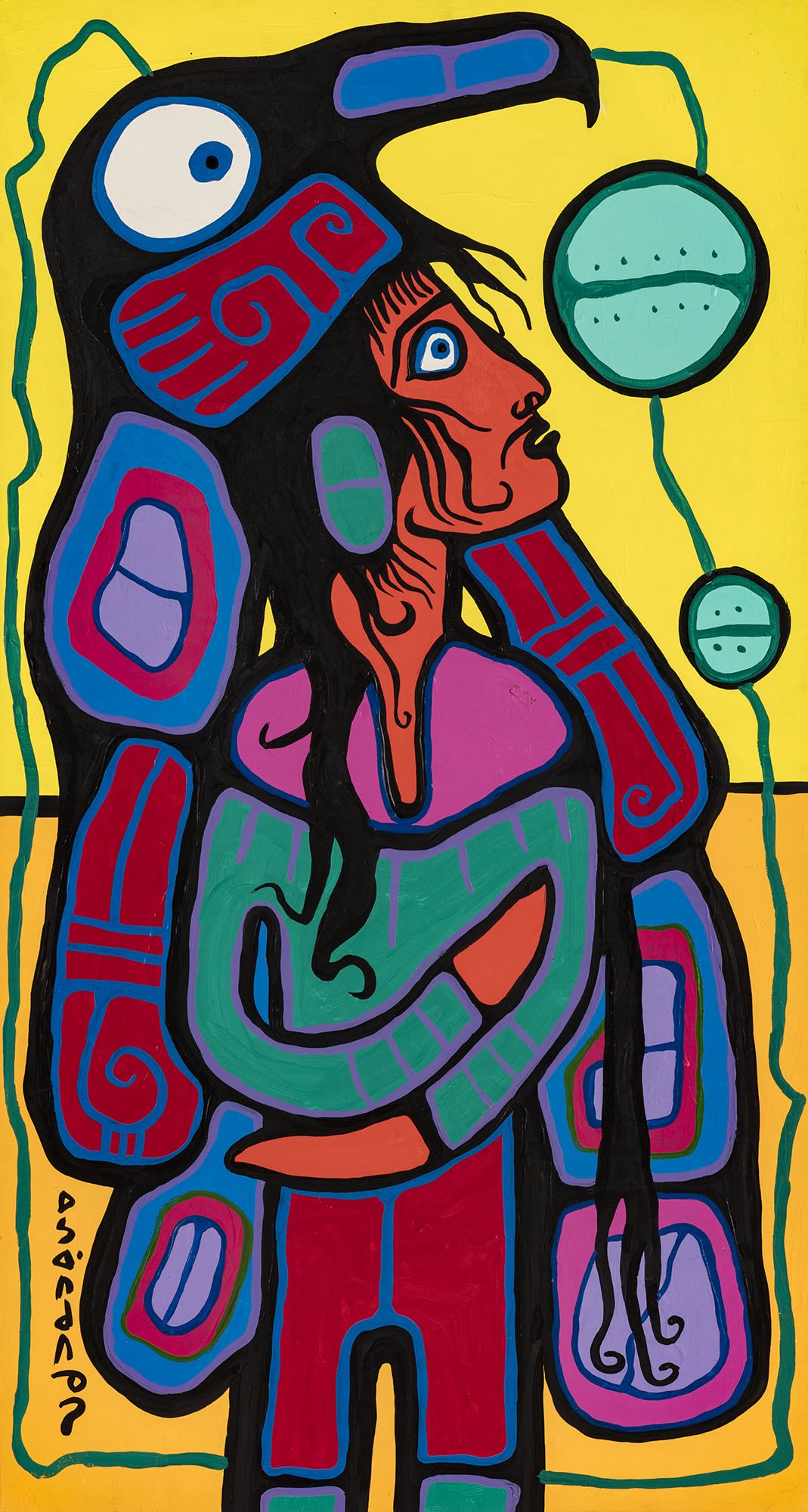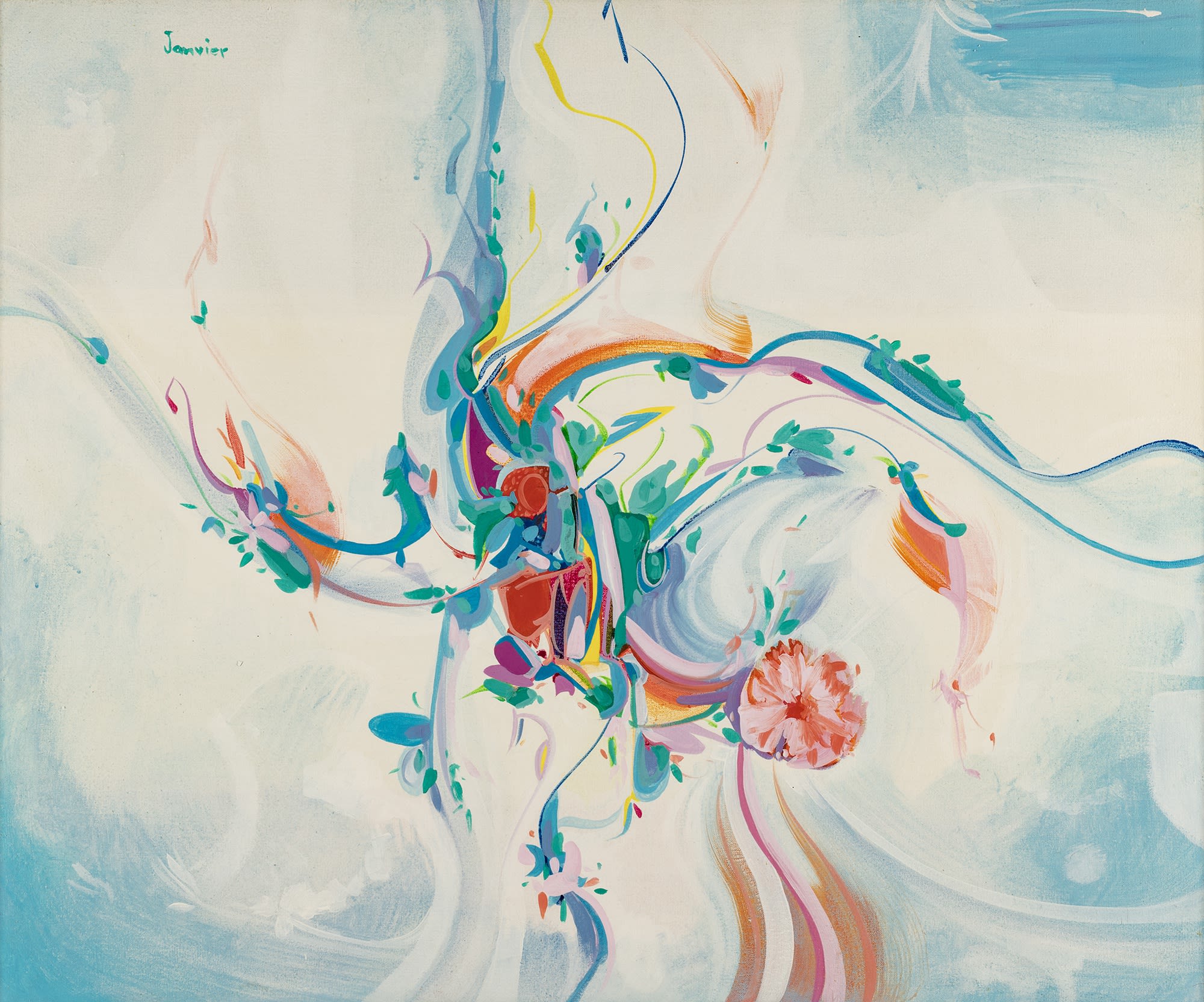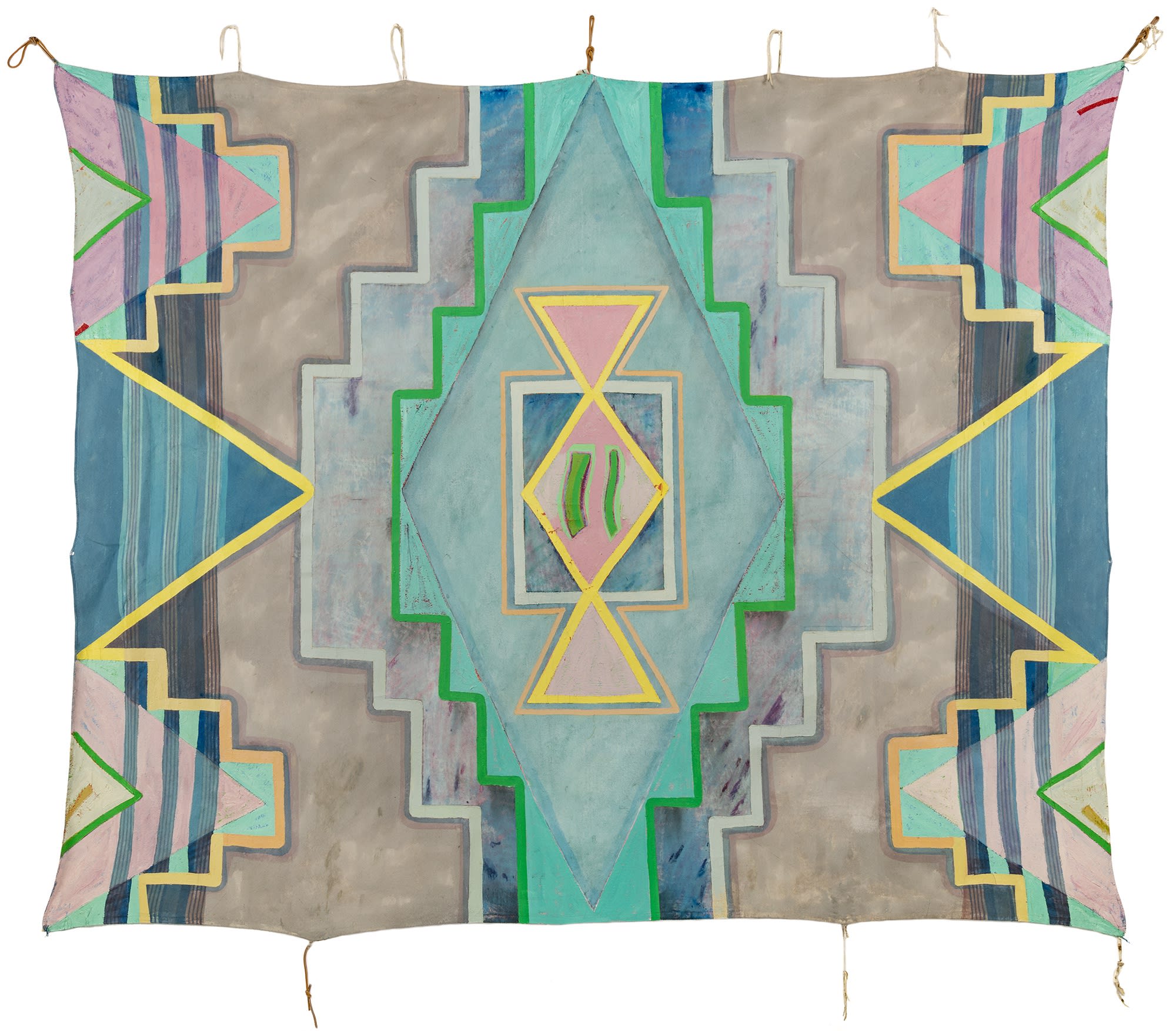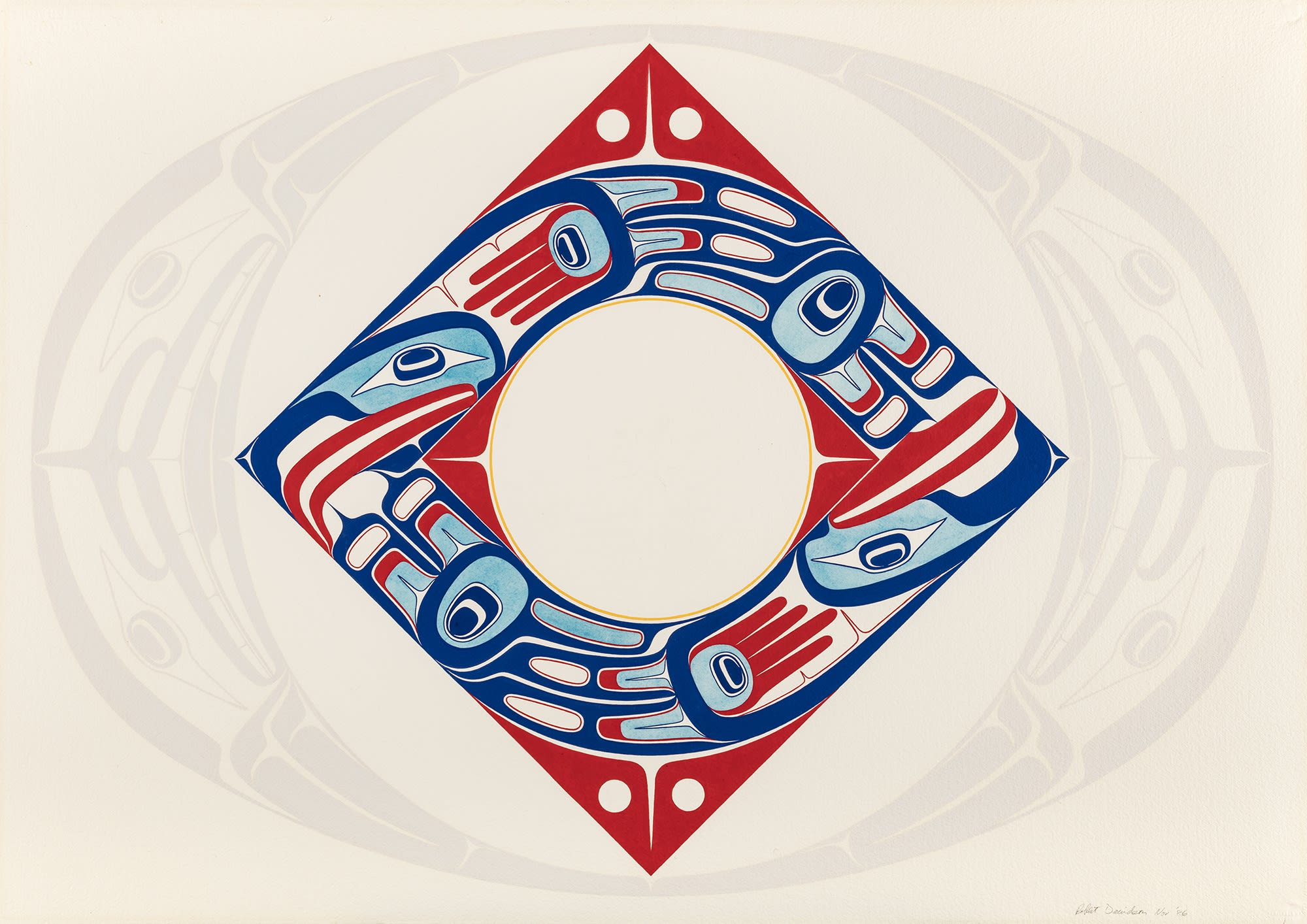The 1960s marked a pivotal shift in the Canadian art scene with the emergence of the so-called Woodlands School, where artists like Norval Morrisseau, Jackson Beardy, and Saul Williams began popularizing Indigenous graphic art across North America.
This transformative era laid the foundation for artists such as Alex Janvier, Bob Boyer, and Robert Houle, who further challenged and expanded the narrative, incorporating contemporary and diverse artistic expressions. In a similar spirit, Northwest Coast artists Robert Davidson and Lawrence Paul Yuxweluptun have continued this trend, boldly infusing traditional forms with a modern sensibility.
The collective contributions of these artists have continuously evolved the perception of Indigenous graphic art, fostering a dynamic and inclusive exploration of Indigenous identity, culture, and history within the context of Canadian art.
Emergence of “The Woodlands School”
During the 1960s in Canada, the Woodlands School began to gain recognition as Norval Morrisseau's work came to prominence. Public reception was one of curiosity and admiration for the vivid spiritual and culturally rich storytelling found in Woodlands style art. This movement marked a significant moment in Canadian art history as it elevated Indigenous perspectives to broader national awareness, challenging established art narratives and garnering both public and critical acclaim. Pioneers like Morrisseau, Jackson Beardy, and Saul Williams merged their personal stories with traditional symbols, creating distinctive works that both honoured their Indigenous roots and expanded the horizons of Canadian art.

Lot 111
NORVAL MORRISSEAU, C.M. (1931-2007) ANISHINAABE
Young Ojibwa Indian Man Wearing Eagle Headdress, c. 1992
ESTIMATE: $20,000 — $30,000
Norval Morrisseau is often hailed as the grandfather of the Woodlands School. His work, characterized by heavy black outlines and a bright palette, blends narratives that are both personal and mythological. His painting Young Ojibwa Indian Man Wearing Eagle Headdress (Lot 111) exemplifies his use of symbolism; here we see a young man adorned with an eagle headdress that represents strength and foresight, suggesting a sacred connection with the spiritual realm. Morrisseau's stylistic evolution, influenced by his companion Gabe Vadas, introduced the distinctive curled hairstyle in his figures, reflecting his blend of personal and cultural narratives.

Lot 114
JACKSON BEARDY (1944-1984) ANISHINAABE (OJI-CREE)
Untitled (Creation), 1980
ESTIMATE: $6,000 — $9,000
Jackson Beardy's work carries forward the storytelling tradition with a focus on the cyclical nature of life. His art, often featuring animals and elements from nature, employs flowing lines and divided circles to depict life's journey and interconnectedness. In Untitled (Creation) (Lot 114), the goose and embryonic chick tethered by colourful bands in his canvas express the full arc of life. The sun motif surrounded by lines marking the cardinal directions and threads connecting life forms speaks to the omnipresence of the Great Spirit, Kitche Manitou.

Lot 112
SAUL WILLIAMS (1954- ) ANISHINAABE, NORTH CARIBOU LAKE FIRST NATION, WEAGAMOW, ON
Kingfisher, 1997
ESTIMATE: $2,500 — $3,500
Saul Williams, inspired by the senior artist Carl Ray, also developed his distinct approach within the Woodlands School. His meticulous artistry and the harmonious blend of color and shape forge a complex scene of interconnected elements, exemplified in his acrylic on paper work Kingfisher (Lot 112). This avian figure, emblematic of prosperity, showcases Williams's intricate detailing and his skill in embedding his work with deep significance via Indigenous symbolism.
Broadening the Narrative
Confronting the notion that the Woodlands School was emblematic of all First Nations graphic art, a number of artists including Alex Janvier, Bob Boyer, and Robert Houle sought to expand the definition of Indigenous art to include diverse artistic expressions that respected traditional roots while affirming their distinct voices and styles.

Lot 113
ROBERT HOULE, R.C.A. (1947- ) NAHKAWININIWAK (SAULTEAUX / PLAINS OJIBWAY)
Untitled (Abstract with Thunderbird on Blue), 1998
ESTIMATE: $7,000 — $10,000
Robert Houle, for instance, with his Anishinaabe roots, blended traditional Woodlands iconography with elements of Western art theory, challenging the notion that Indigenous art must adhere to a single stylistic narrative. Works like Untitled (Abstract with Thunderbird on Blue) (Lot 113) showcase a sophisticated interplay between abstract art techniques and potent Anishinaabeg cultural symbols, in this case the Thunderbird. Houle's ability to depict such powerful Indigenous emblems within an abstract framework not only broadens the aesthetic dimensions of Indigenous art but also serves as a reminder of its dynamic and evolving nature.

Lot 101
ALEX JANVIER, C.., A.O.E., R.C.A. (1935- ) DENESULINE AND SAULTEAUX, COLD LAKE, AB
Blue Lake Sky, mid. 1980s
ESTIMATE: $20,000 — $30,000
Similarly, Alex Janvier's unique fusion of Dene (Chipewyan) motifs and Modernist techniques such as Automatism, has helped to redefine Indigenous art within the context of Western art history. His work, particularly noteworthy from the late 1960s onwards, has been pivotal in showcasing the natural themes and aesthetics of his Indigenous roots through an abstract lens. As an example, Blue Lake Sky (Lot 101) is not just an abstract expression, but a canvas imbued with cultural symbolism, drawing from Denesuline beadwork and natural elements like the water and flora of Blue Lake, Alberta.

Lot 102
BOB BOYER, R.C.A. (1948-2004) MÉTIS
Cohokia Today, Fall 1989
ESTIMATE: $10,000 — $15,000
Bob Boyer used his art to address historical and contemporary issues affecting Indigenous peoples. By adopting blankets — objects with deep roots in Indigenous traditions and with problematic connotations regarding colonial history — as his canvases in the 1980s, Boyer created a powerful commentary on identity and history. His work Cahokia Today (Lot 102) intertwines traditional Plains symbology with abstract art, reflecting on historical narratives and Indigenous architectural achievements. Boyer's artistic language challenges dated stereotypes and invites viewers to engage with a nuanced understanding of Indigenous cultures and their artistic expressions.
New Horizons in Northwest Coast Graphic Art
In the same vein as artists like Houle, Janvier, and Boyer, on Canada’s Northwest Coast Robert Davidson and Lawrence Paul Yuxweluptun have each marked their own impact on the diversity and understanding of Indigenous art in Canada. With their roots in Northwest Coast artistry, they have embraced and transformed traditional forms, contributing to the vibrant, evolving art movement of Indigenous graphic art.

Lot 93
ROBERT DAVIDSON (GUUD SANS GLANS), O.C., O.B.C. (1946- ) HAIDA, MASSET / WHITE ROCK
Untitled (Recollections or The Marriage Announcement), November 1986
ESTIMATE: $30,000 — $50,000
Robert Davidson, through his innovation of "shape within a shape" and introduction of "ghost forms," has expanded the visual language of Haida art. His work Untitled (Recollections or The Marriage Announcement) (Lot 93) challenges and advances traditional Haida forms, adding layers of meaning and exploring the supernatural realm.

Lot 140
LAWRENCE PAUL YUXWELUPTUN (1957- ) COAST SALISH / OKANAGAN, COWICHAN / SYILX FIRST NATIONS
Study for "An Indian Game (Juggling Books), 1996
ESTIMATE: $2,000 — $3,000
Lawrence Paul Yuxweluptun confronts and critiques contemporary Indigenous identity and politics. Works such as Study for “An Indian Game (Juggling Books)” (Lot 140) tackle difficult themes of race and representation, offering a poignant commentary on the Indigenous experience within and beyond the art world. His provocative approach extends the narrative of Indigenous graphic art, expanding its scope to include a multitude of expressions and critical reflections on identity, culture, and history.
Each of the above artworks embodies a chapter of cultural storytelling and identity, reflecting a rich legacy of transformation and the ongoing dialogue of Indigenous voices in Canada’s artistic landscape.
First Arts is proud to offer these original graphic works in our upcoming Fall 2023 live auction of Inuit & First Nations Art (Monday 4 December 2023 at 7 PM ET).
